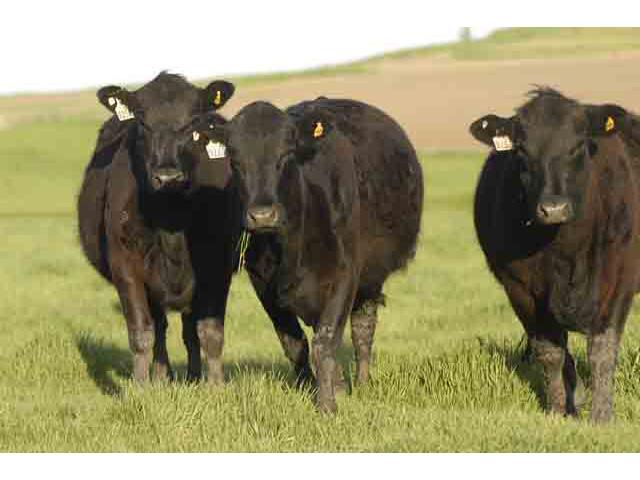Culling Cows Cleverly Increases Income
How to Get More Money Out of Selling Cull Cows
OMAHA (DTN) -- To some cow-calf producers, culling cows might just be a normal chore of loading up some cows and hauling them to the local sale barn. These are probably older and/or open cows that are not wanted and just need to go to town.
Cull cows, however, represent significant profits for cow-calf producers. Different strategies can be used to increase the amount of money a producer can receive for these cattle, according to Extension ag economists.
BE STRATEGIC WITH CULLING
In a recent University of Nebraska-Lincoln (UNL) Extension Center for Agricultural Profitability webinar titled "Culling Cows for Profit," UNL farm management specialists Jay Parsons and Matt Stockton discussed ways cattle producers can get more for their cull cows (https://cap.unl.edu/…). Tactics include selling at different times of the year to find higher cattle prices and even feeding these cows in a way to increase profits.
Stockton said research has shown most cattle operations have a turnover rate close to 20% of the total cow-calf herd. Cull cow revenues typical make up roughly 10% to 30% of the total herd revenue, he said.
A 2019 Nebraska cow-calf budget put together by UNL shows the percent cull revenue ranged from 8% in northeastern Nebraska herds to 21% in the vast Nebraska Sandhills region. Cull revenue ranged from $80/cow to $169/cow in the same two areas of the state.
It is important for producers to be strategic with their culling, according to Stockton.
"Using available feed, facilities, production systems and expertise can really make a difference in returns (with cull cows)," Stockton said.
Parsons said producers should consider three main areas: reduce cull rates, reduce replacement costs and increase cull cow value.
First, reduce cull rates by changing the longevity of cows: this includes reproductive efficiency, supplemental feeding and herd health.
Second, change the cost of replacement females. Some producers buy their replacement heifers to get certain genetics, while others raise their own replacements to save some costs.
P[L1] D[0x0] M[300x250] OOP[F] ADUNIT[] T[]
"Every operation probably has different approaches when it comes to these areas," Parsons said.
Third, to increase cull cow values, Parsons pointed to a few different practices cattle producers can implement to increase how much money they receive for their cull cows.
CONSIDER SELLING TIME
What time of year you sell cull cows affects how much money you get for these animals. Most cow-calf operations with spring calving sell cull cows in the fall when cows are preg checked and found to be open or perhaps have some sort of health issue.
Parsons said the cattle market's low point for cull cows is usually in October and November -- the same time producers sell those cull cows. These prices tend to be low until about February and then an uptick in the cull cow market usually occurs from April through August.
Stockton said one good strategy for cows getting older is to consider weaning a calf early and sell the cows into the cull cow market in August instead of fall. It takes more management, but you also might get more money for the cull cow you are selling, he said.
Another strategy is to feed the cows to improve their cull grade. The different cull cow grades are commercial, utility, cutter and canner, he said. Research shows that there is an 18% price increase from going from cutter to utility and 24% price increase going from utility to commercial levels.
So, feeding cull cows to get to the utility or commercial grades could help earn some additional profits, Stockton explained.
Parsons said cows in thin condition (cutter) could be fed up a grade in 45 days or up two grades in 90 days. Different diets produce different average daily gains (ADG) with a forage diet gaining 1.5 pounds per day while a corn/silage diet would produce 3 lbs/day ADG.
FEEDING CULL COWS PAYS -- SOMETIMES
He stressed feeding cows to improve cull cow grades pays only when certain factors can be achieved: improving a grade classification (or two), cattle go to market from February to April, cattle prices are trending higher and feed costs are low relative to cattle prices.
When feeding cull cows to improve their grade, there are several cost considerations, Parson said. These include feed costs, yardage (facilities), labor, interest and death loss.
"A drought year like we had this growing season where feed costs are high and supplies are tight would probably not be when most producers would want to try to do this," Parsons said.
Stockton said partial budgets can be run to see if feeding of cull cattle is a profitable enterprise. Budgets can be created by using the website www.rightrisk.org.
Stockton created his own budget. Inputting some numbers such as increasing from canner cow price ($0.75/lb) to cutter price ($0.83/lb) and adding 360 lbs of weight to a cow, this increases revenue to $766.05/head.
He estimated a ration that costs $619.02/head, $48/head for yardage, $20/head for miscellaneous and $30/head for increased return with some adjustments to death loss. The total estimated cost to feed out a cow would be $721.77/head.
That leaves $44.28/head estimated profit in this scenario, he said.
Stockton said every cattle operation would have different factors to decide if feeding cattle to improve cull grades would pencil out. Producers should see for themselves if this would increase what they get for their cull cows, he noted.
**
Editor's note: See more DTN coverage on culling cattle at:
Russ Quinn can be reached at Russ.Quinn@dtn.com
Follow him on Twitter @RussQuinnDTN
(c) Copyright 2022 DTN, LLC. All rights reserved.






